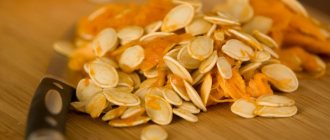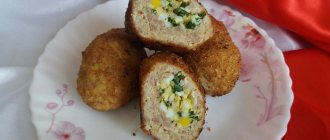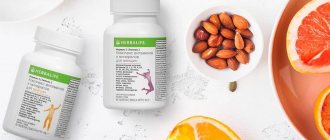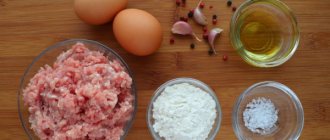- Is it possible to eat horse meat?
- Meat composition
- Calorie content and nutritional value of BJU
- Calorie content of kazy per 100 grams
- Calorie content of dried horse meat
- Why is it useful?
What is horse meat? This is horse meat used for food. The most delicious dishes are obtained from the meat of 9-12 month old foals, but the meat of older (one to three year old) animals is also used in cooking.
Horse meat
The most famous sausages are those made from horse meat. But the product is also suitable for preparing other dishes. The favorite dishes of the Turks and Mongols are kazy, zhal, shuzhuk, besbarmak, pilaf, and the Japanese are sashimi. Italians add horse meat to spaghetti, and the Swiss deep-fry it.
In Sweden, Belgium and France, horse meat is often eaten raw. Tartar is prepared from it - the chopped pulp is seasoned with hot sauce, onions, herbs, and spices.
Kumis is also used as food - this is the name given to sour mares' milk. Cottage cheese and chigyan are also made from it.
Is it possible to eat horse meat?
Answer to the question: “Can I eat horse meat?” ambiguous. Representatives of different nations have different attitudes towards horse meat. You cannot eat horse meat in Ireland, Great Britain, USA, Canada. Jews, gypsies, Indians, Spaniards and Brazilians do not eat it. For Mongols, Turks, Kazakhs and Kyrgyzs, horse meat serves as everyday food, and among the Japanese it is considered a delicacy.
Are horse legs used for food? Jellied meat is prepared from them. The dish turns out very dense, elastic, transparent and tender.
Kazy – Kazakh boiled horse meat sausage
Skeptics have no reason to claim that horse meat is low quality meat. Its chemical composition is similar to beef, it is easier to digest and has a pleasant taste. Horse meat is red; when cooked, the sausage acquires a beautiful brown color with an amber tint. It should be noted that in the USSR, horse sausage made from 100% horse meat was very popular and available on the food market.
You can make horse sausage at home; if you are lucky enough to buy horse meat, you just need to follow the following recipe.
Required ingredients:
- horsemeat category 1-3 - 10 kg;
- fat - 2 kg;
- sausage spices:
- ground pepper to taste;
- garlic - 100 g;
- guts for casing;
- salt -250 g.
Cooking method:
- Pass meat of 1-2 categories through a meat grinder onto a large mesh. Grind the stringy pieces of meat through a fine mesh. Traditionally, the meat was cut into strips.
- Cut the fat into cubes measuring 4x4 mm.
- The meat is mixed with salt and saltpeter and refrigerated for 2-3 days.
- After the time required for marinating the meat has passed, add spices and garlic.
- The resulting mass is filled with the intestines.
- The resulting semi-finished product is cooked until cooked for 2-3 hours.
- They are consumed boiled or then dried in a hanging form for 2-3 months or smoked over slow smoke.
Meat composition
Among all types of meat, horse meat is the leader in molybdenum and calcium content. It is significantly superior to beef in the concentration of organic acids and iron. Horsemeat also contains vitamins (A, C, E, K, group B), macro- and microelements.
Composition of horse meat
(per 100 grams)
| Water | 64-70 |
| Squirrels | 21 |
| Fats | 5-10 |
| Vitamins | 9 |
| Macronutrients | 7 |
| Microelements | 2 |
Horse meat contains almost no cholesterol. Therefore, it is used in dietary nutrition.
Dangerous qualities
Excessive consumption of horse meat can stimulate the development of diseases of the gastrointestinal tract, kidneys, bone and cardiovascular systems. This meat can be harmful to people who purchased it from unverified suppliers, as it can be contaminated with trichinella, the most dangerous parasites.
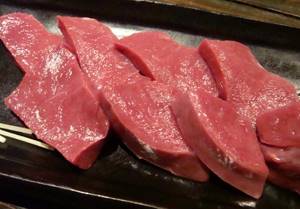
Therefore, horse meat must be subjected to heat treatment for a long time. It should also be remembered that this type of meat, like any other protein product of animal origin, is a source of purines, which are contraindicated in individuals with high levels of uric acid and gout. In such cases, you need to either completely exclude it from your diet or reduce consumption to a minimum.
Young stallions have a very active lifestyle, so there is practically no cholesterol or fat in horse meat. Thanks to this, fresh meat consists only of muscle tissue. You cannot save it for a long time, as it spoils very quickly. When frozen, the beneficial properties of horse meat are completely lost.
Calories and nutritional value
How many calories are in horse meat? Calorie content per 100 grams – 119-187 kilocalories. The most high-calorie meat is located on the ribs and in the abdominal region, since it is in these parts that fat is deposited. In addition, with age, the water content in horse meat decreases and the amount of fat increases.
During cooking, the calorie content of the product increases. The nutritional value of smoked horse meat is 190 kilocalories, dried - 200, stewed - 214, boiled - 240, fried - 290, dried - 300.
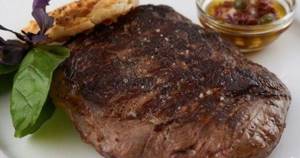
Baked horse meat
Horse meat is superior in composition and taste to beef, lamb and pork.
BJU
How much protein is in horse meat? What is the BJU indicator for horse meat? The product contains 21 grams of protein (per 100 grams). Consequently, in terms of protein content (they are characterized by a well-balanced amino acid composition), horse meat is superior to all other types of meat. At the same time, there is very little fat (2.5-5 grams). It is fundamentally different from the fat of other animals and is identical in composition to vegetable oil. Horse fat is very soft. If you pick it up, it melts, which is why horse meat is never marbled. There are no carbohydrates in horse meat.
Calorie content of kazy per 100 grams
When preparing sausages, the nutritional value of the product greatly increases. The calorie content of kazy is 445 kilocalories per 100 grams, and other types of boiled-smoked sausages are 350.
Calorie content of dried horse meat
The calorie content of dried horse meat is 200 kilocalories per 100 grams, and basturma (dried tenderloin) is 240.
Horse fat
Many people ask whether horse meat is healthy. Yes, very useful. It is known that it contains a minimum of fat, which differs significantly from both pork and beef. It is identical in composition to vegetable oils, and its beneficial qualities are predetermined by its pronounced choleretic effect and low cholesterol content. It is thanks to the first property that horse meat is best eaten by those who suffer from biliary dyskinesia and liver ailments.
The unique qualities of horse fat help a person recover faster from jaundice. And the fat itself is often used by cosmetic companies to create beauty-preserving products. In addition, it is used for burns and frostbite.
Is horse meat sausage healthy? Horse sausage (kazy) is a Central Asian national dish. In Mongolia, Kyrgyzstan, and Kazakhstan, nomadic tribes still prepare it by hand with the whole family today. Men slaughter 2-3 year old horses, bred specifically for this purpose, and also cut the meat. Women process the intestines and make kazy.

Horse sausage is as healthy for humans as horse meat. It is a worthy decoration for the holiday table, very pleasant to the taste and an environmentally friendly dish. The filling for kazy is prepared from the rib segment of a horse, cutting it into strips.
Next, the meat is seasoned with a mixture of black pepper, salt and garlic and stuffed tightly into well-washed intestines. The shape of the sausage can be very different, but the length is no more than 70 cm. Kazy is sent to a dry place to be soaked in spices, and then smoked, fried, dried or boiled. Sausage is eaten both as an additive to pilaf and in its natural form.
In addition to kazy, such types of horse sausage as shuzhuk and makhan are very popular. The heat treatment of shuzhuk is identical to kazy, but the filling is minced meat from any segment of the carcass.
https://www.youtube.com/watch?v=uNbKwr484os{amp}amp;t=1s
Makhan is a “dry” or dry-cured sausage, very specific and dense. It is prepared from fat and horse meat with seasonings.
What does horse meat taste like?
Many Europeans are sure that horse meat tastes very vile. But such an opinion is wrong. Most likely, it is explained by the fact that during the retreat from Moscow, Napoleon’s armies ate the meat of dead horses. At the same time, salt and seasonings were replaced with gunpowder, which became the cause of many food poisonings. In fact, horse meat has a pleasant, albeit specific (slightly sweet) taste and aroma. The meat of older horses may taste bitter and smell bad.
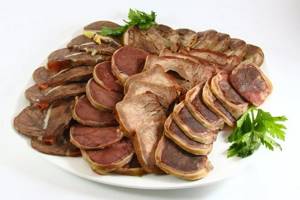
Horse meat delicacies
Horse breeding
Horse meat has a special taste and is a simple but favorite dish among nomadic peoples. Horses are raised on pastures, which requires a lot of land. Short-term (maximum 30 days) stall housing for fattening is allowed. If a horse is kept in captivity longer, this has the most negative effect on the taste of the meat and its consistency. Among agricultural sedentary peoples, the use of horse meat is, as a rule, not widespread.
The agricultural importance of horse meat depends very much on local natural and geographical conditions. Thus, throughout Europe, it is profitable to breed horses for meat only in Hungary. There are no natural pastures in Japan, so breeding horses there is not a cheap endeavor. At daimyo's feasts in the Middle Ages, horse meat was sometimes served, the value of which lay in its incredible cost.
Horse meat: benefits and harm to the human body
If abused, horsemeat can cause harm instead of benefit. Therefore, you should not get too carried away with the product. Two hundred grams a day is enough for men, one hundred for women, and seventy for children and the elderly. Introduce horse meat products into the diet no more than three times a week.
It should be noted that horse meat quickly deteriorates, which is why it can cause poisoning. In addition, it is often contaminated with salmonella and trichinella. Therefore, horse meat requires long-term heat treatment.
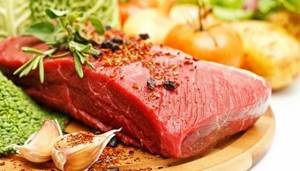
Horse ham boneless
Why is it useful?
Having studied the composition of the product, we can say how horse meat is useful:
- B vitamins normalize metabolism and stimulate nervous activity;
- Vitamin E has a neutralizing effect on free radicals, due to which it triggers a rejuvenation mechanism and prevents cancer;
- Vitamin A improves vision;
- Phosphorus and calcium strengthen bone tissue, thereby minimizing the risk of fractures and the development of diseases of the musculoskeletal system;
- Magnesium and potassium strengthen the myocardium, improve cardiac activity;
- Iron and copper are involved in the process of hematopoiesis (production of red blood cells) and increase hemoglobin levels;
- Antioxidants inhibit the growth of cancer cells, slow down the aging process, strengthen the immune system and increase the body's resistance to infections.
Is it possible to have horse meat for pancreatitis?
People suffering from pancreatitis often ask whether or not they can eat horse meat. There is no doubt that the product will benefit patients and improve their condition. It stabilizes the functioning of the pancreas and speeds up recovery. But horse meat for pancreatitis can only be eaten boiled.

Horsemeat cooked over an open fire
Description
Not many people know the benefits of horse meat.
Very often, people prepare dishes from the meat of young trotters up to 3 years old. But the most palatable and nutritious is the meat of foals 9-12 months old. To create horse meat, both adult cull horses and super-repair young animals are suitable. Horse meat began to be consumed in the pre-Christian era. Calvin Schwab's book The Forbidden Kitchen states that horse meat was always served at the table during various occult ceremonies of the Teutons. According to the information of the famous wanderer Marco Polo, earlier the peoples of Central Asia used mares' milk in small doses to maintain strength, from which fermented milk drinks and cottage cheese, and horse blood were also prepared.
https://www.youtube.com/watch?v=ytpressru
Today, horse meat is eaten mainly in Asia and Europe. On the Old Continent, the most optimal circumstances for breeding horses for meat are in the south of France and Hungary. Horse meat is especially popular in Kyrgyzstan, Kazakhstan and Mongolia. This meat is banned in English-speaking countries - Ireland, USA, Canada, Great Britain. It is also not eaten by gypsies and Jews, residents of Brazil, India and Spain (although this state is a major exporter of trotters).
Horse meat is quite tough meat. It has a specific aroma and taste. First it is marinated or smoked and only then boiled. It becomes soft only after several hours of cooking. Horse meat makes excellent sausages, for example, servelat or oriental kazy-karta - they are viscous, elastic, with a refined flavor.
Among the Turkic and Mongolian peoples, the most favorite dishes from this type of meat are shuzhuk, kazy, besbarmak, zhal and others.
In European countries, for example in Belgium, Sweden and France, horse meat is consumed raw. Often sliced meat is served as tartare, seasoned with onions, spices and herbs, or with hot sauce. In Japan, one of the traditional dishes - sashimi - is prepared from horse meat. In the southern regions of France, sausages made from crumbled horse meat are eaten - they are fried over an open fire, frying pan or grill. In Italian cuisine, this type of meat is a component of the “Spaghetti with Bolognese sauce” dish, and in Switzerland it is cooked in a deep fryer.
Horse liver: benefits and harms
Horse liver is saturated with useful substances, especially vitamins A, D, E, K and group B. It also contains proteins, amino acids, and mineral elements. Thanks to its rich composition, the product improves visual acuity, activates brain function, enhances hemoglobin synthesis, has a beneficial effect on liver function, strengthens teeth, gives smooth skin and thick hair, prevents the formation of atherosclerotic plaques and the development of thrombosis.
Horse meat liver will especially benefit children, pregnant women, people diagnosed with diabetes, atherosclerosis, anemia, as well as smokers.
But in any case, a healthy product should be eaten in limited quantities so that it does not cause harm.

Horse liver
Kazylyk: benefits and harms
Horse meat is widely used in sausage production. Servelat, kazy (kazylyk), makhan, tutyrma (sujuk) are made from it. Sujuk can also include lamb or beef. Horse meat is also added to other types of sausages, due to which they become elastic and acquire a piquant taste.
Among all types of sausages, the most delicious is kazy. In Tajikistan and Uzbekistan, it serves as a festive dish. Kazylyk made from horse meat not only has an exquisite taste, but also benefits the body - it activates metabolism, promoting weight loss, and improves the functioning of the gastrointestinal tract.
Kazylyk can also cause harm to some people. Therefore, it is strictly contraindicated for gout. In addition, horse sausage is a natural product, which is why it can become infected with parasites. To avoid such a danger, you need to buy sausage only from trusted retail outlets.
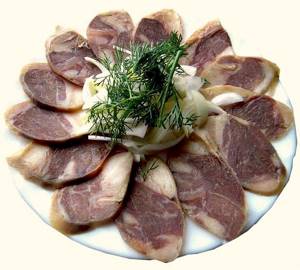
Kazylyk
Cooking methods
Horse meat is very tough. To make it soft, it is recommended to cook for several hours (at least two), after soaking in water and marinating. Long-term cooking will also avoid infection with parasites.
Horse meat steak in 20-30 minutes
Most often, horse meat is boiled or stewed. Roasted meat (as well as from old animals) may have an unpleasant taste and odor. In addition, it is saturated with carcinogens and causes disruptions in the gastrointestinal tract.
To get rid of the specific smell, add onions or garlic to the meat and stuff it with prunes.
A stew made from horse meat with vegetables and spices has an exquisite taste. Horse meat goes best with turnips, carrots, peppers, tomatoes, celery, onions, and garlic.

